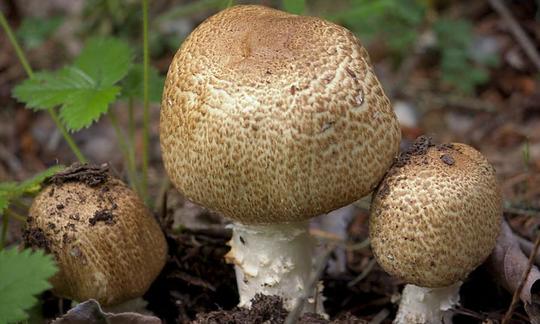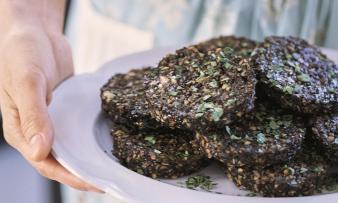Table of contents
The giant mushroom ( Agaricus augustus), which is a member of the agaric family, has a mild almond-like smell and is mainly found in coniferous forests between July and October. This wild-growing edible mushroom can be eaten raw.
Use in the kitchen
Is the giant button mushroom edible? Giant button mushrooms are edible mushrooms and have a sweet taste that smells like bitter almonds and is also reminiscent of anise. In the kitchen, they can be used in just as many ways as cultivated button mushrooms ( Agaricus biosporus, e.g. Portobello). They can be sliced, chopped, roasted, steamed, deep-fried, marinated or grilled. Raw, they taste just as good in a raw vegetable salad as they do with various vegetables in dips. What giant button mushroom recipes are there? The wild edible mushroom goes perfectly in vegan pasta dishes, rice dishes (e.g. risotto), vegetable stir-fries, casseroles, soups or mushroom stir-fries with other mushrooms (e.g. cultivated button mushrooms, chanterelles, king oyster mushrooms, shiitake mushrooms, etc.).
Due to its size, the giant mushroom can be stuffed with other vegetables and baked in the oven. Young specimens that have not yet opened their caps are ideal for this. When fully grown, it serves as a good meat alternative, for example as a vegan burger. Mushroom dishes can be skilfully refined with spices such as thyme, sage, rosemary or lovage. When cleaning the mushroom, you should use a cloth or a mushroom brush and not water, as otherwise the mushrooms will swell.
Vegan recipe for stuffed giant mushrooms
Ingredients (for 2 people): 6 young giant mushrooms, 2 cloves of garlic, 1 onion, 1 handful of macadamia nuts, 1 small red chili pepper, 2 tbsp yeast flakes, 3 tbsp rapeseed oil (refined), 1 tbsp soy sauce.
Preparation: Brush the giant mushrooms clean, remove the stems and chop into small pieces. Finely chop the garlic cloves and onions. Chop the macadamia nuts into small pieces (if necessary in a high-performance blender). Chop the peppers into small pieces. Mix the chopped ingredients together with yeast flakes, rapeseed oil and soy sauce and spread the mixture into the mushrooms. Finally, finish cooking the stuffed mushrooms for 10 minutes on the grill, in a pan or in the oven (at 180 °C convection).
The leftover filling goes well with pasta or rice.
Vegan recipe for lukewarm salad with giant mushrooms
Ingredients (for 2 people): 200 glettuce, 2 giant mushrooms, 1 clove of garlic, 1 onion, 100 ml vegetable stock, 1 teaspoon chopped dill, 1 teaspoon chopped parsley, 2 teaspoons pine nuts, 4 tablespoons rapeseed oil (cold-pressed), 6 tablespoons red wine vinegar, 1 teaspoon mustard, salt andpepper (to taste).
Preparation: Press the garlic and cut the onion into small pieces. Mix the oil and red wine vinegar. Add the garlic, onion and herbs and mix. Brush the giant mushrooms clean and cut into slices. Bring the vegetable stock to the boil, add the wild mushrooms and simmer covered for 2 minutes. Remove the lid and cook the mushrooms, stirring, until the liquid evaporates. Season with salt and pepper. Mix half of the mushrooms with the salad dressing. Cut the lettuce and wash the lettuce leaves. Put the salad in a bowl and mix with the sauce. Arrange on two plates and garnish with pine nuts and more mushrooms.
Vegan recipes with giant mushrooms can be found under the note: " Recipes that have the most of this ingredient ".
| Not only vegans or vegetarians should read this: Vegans often eat unhealthily. Avoidable nutritional errors. |
Purchasing - Storage
The season for giant mushrooms lasts from July to October. They are only found in the wild, which is why they are not available in major retailers such as Coop, Migros, Denner, Volg, Spar, Aldi, Lidl, Rewe, Edeka, Hofer, Billa or in organic supermarkets such as Denn's Biomarkt and Alnatura.
Alternatively, you can buy the large, brown cultivated mushrooms, often known as Portobellos, online or in well-stocked supermarkets.
Found in the wild
Where can you find mushrooms in the wild? Giant mushrooms can be found from early summer to late autumn 1 in parks, gardens, deciduous forests 2 and coniferous forests. 3 Even though the giant mushrooms are fairly easy to recognize, only mushroom experts should collect them themselves.
What is the structure of a mushroom? When fully grown, the cap has a diameter of around 20 to 30 cm and is yellowish in color with yellow-brown to brown scales. The cylindrical stem is slightly bulbous at the bottom, often slightly curved and has a wide, drooping, yellowish ring (smooth at the top and scaly at the bottom). The edible flesh is white and turns yellow when touched. 3 The cap is not yet shielded in young mushrooms. Which mushrooms could be confused with? There is a possibility of confusion with edible wild mushrooms with brown giant mushrooms ( Agaricus cappellianus), large forest mushrooms ( Agaricus langei) and the small forest mushroom ( Agaricus silvaticus). 4
Storage tips
Giant mushrooms are best stored in a paper bag in the refrigerator for two to three days. Alternatively, you can cut the mushrooms into slices, dry them and store them in airtight jars.
Ingredients - Nutritional values - Calories
What is the nutritional value of giant mushrooms? The energy content of 100 g is 22 kcal. Of this, 3.3 g are carbohydrates, 3.1 g are proteins and 0.34 g are fat. Giant mushrooms mainly contain B vitamins. The mushroom nutrients are the same as those of cultivated mushrooms. 5
Riboflavin (vitamin B2) is present at 0.4 mg/100g (29% of the daily requirement). This means that giant mushrooms contain a similar amount of this vitamin to fresh porcini mushrooms (0.37 mg/100g) or oyster mushrooms (0.35 mg/100g). Dried mushrooms, such as dried porcini mushrooms (1.8 mg/100g) or dried shiitake mushrooms (1.3 mg/100g), contain particularly high levels of riboflavin. 5 However, you generally use less dried ingredients than fresh ones and therefore absorb fewer nutrients.
100 g of the mushroom contains 1.5 mg of pantothenic acid (vitamin B5). This covers 25% of the daily requirement. Pantothenic acid is involved in the human body in processes for energy production, fat metabolism and fatty acid synthesis and contributes to the production of various neurotransmitters (e.g. serotonin). Raw shiitake mushrooms contain the same amount. Another good source of vitamin B5 is beech mushroom, shimeji (2.5 mg/100g). 5
The giant mushroom contains 3.6 mg of niacin (ex vitamin B3) per 100 g (23% of the daily requirement). The vitamin is important in energy metabolism. The human body can also produce it itself from the amino acid tryptophan. Shiitake mushrooms contain similarly high amounts (3.9 mg/100g). Fresh porcini mushrooms contain more than twice as much (8.4 mg/100g). 5
How much potassium is in giant mushrooms? 100 g of giant mushrooms contain 318 mg of potassium. This amount is comparable to 100 g of carrots (320 mg). 5
The typical aniseed scent is due to the organic chemical compound anethole. In one study, samples of Agaricus augustus also contained benzaldehyde, which is responsible for the bitter almond smell. Depending on the concentration, the mushroom can therefore smell more like aniseed or bitter almonds. 16
The complete ingredients of giant mushrooms, the coverage of the daily requirement and comparison values with other ingredients can be found in our nutrient tables. In the article Nutrients explained you will get a detailed insight into the topic.
Health effects Edible
mushrooms are generally a valued source of nutrition for humans due to their low calorie content and high content of carbohydrates, proteins, fiber, phenolic compounds, polyunsaturated fatty acids, vitamins and minerals. 6
There is little research into the health effects of the giant mushroom itself. Although some sources list it as a medicinal mushroom, along with other types of mushroom, we are not aware of any studies that provide solid evidence for this statement.
Dangers - Intolerances - Side effects
Since giant mushrooms - like all wild mushrooms - tend to absorb heavy metals from the soil and store them in the fruiting body, you should be careful when eating them. 4 Tolerance values only exist for cultivated mushrooms. 7 Contamination can occur through car exhaust fumes, sewage sludge, compost, incineration plants, furnaces or waste incineration plants, both through the soil and through the air (through dust particles) and varies depending on the location of the mushroom. 7 In particular, you should not collect wild species near fertilized and pesticide-contaminated agricultural areas. 4 Agaricus augustus are frequently contaminated with cadmium. 7 Cadmium is considered to be extremely toxic and potentially carcinogenic. 8 In addition, continuous intake can damage the liver and kidneys. 7 However, taking into account the collection location and if consumed irregularly and in small quantities, eating the edible mushroom is safe.
Although it is easy to recognize, there is always a risk for the untrained eye of confusing it with numerous mushrooms, some of which are poisonous.
Risk of confusion
There is a risk of confusion with poisonous lookalikes with the sharp-scaled parasol mushroom ( Lepiota aspera), the guinea fowl fungus ( Agaricus moelleri), the partridge fungus ( Agaricus phaelepidotus), the yellow ( Amanita citrina) and the green death cap mushroom ( Amanita phalloides). 4 These can often be identified by an unpleasant smell of carbolic acid (ink, medicine cabinet) or fish. 1
The large, brown, edible cultivated mushroom Portobello ( Agaricus biosporus) looks similar to the wild giant mushroom ( Agaricus augustus). You often read about giant mushrooms when you mean Portobello mushrooms.
Ecological footprint - animal welfare
The CO 2 footprint of food depends on many factors, including the cultivation method (conventional/organic), the country of origin, transport, processing and packaging. 9 Since giant mushrooms are not cultivated commercially and are only found in the wild, neither artificial irrigation nor other interventions in the natural ecosystem are necessary. In addition, no industrial processes or materials are required for processing and packaging.
1 kg of fresh cultivated mushrooms (light or dark) have a CO 2 footprint of around 1.3 kg CO 2 eq/kg. For canned mushrooms, the value is almost twice as high at 2.4 kg CO 2 eq/kg. 9 The Danish climate database CONCITO calculates an ecological footprint for Portobello mushrooms of 0.26 kg CO 2 eq/kg in 2024 (in 2021 it was: 0.36 kg CO 2 eq/kg). 10
In general, fresh, unpackaged, seasonal and regional vegetables have the lowest emissions. Agaricus augustus is therefore likely to have a relatively low ecological footprint. However, despite extensive research, we were unable to find any precise values for this. Collecting the mushrooms yourself and processing them is definitely the most environmentally friendly option.
Worldwide occurrence - cultivation
Giant mushrooms prefer humus-rich soil and can be found in parks, gardens, deciduous forests 2 and coniferous forests 3, mainly in temperate latitudes in the northern hemisphere. 11 Their harvest time is from early summer to late autumn. 1
Cultivation - Harvest
Often there are special environmental conditions in forests and meadows that are difficult to create for growing mushrooms in your own garden or on the balcony. 12 A rough distinction is made between saprophagous and mycorrhizal fungi. The latter can only grow and thrive in symbiosis with certain living plants. These include some noble mushroom species, such as porcini, morels or chanterelles. With saprophagous mushroom species, such as button mushrooms, shiitake or oyster mushrooms, cultivation is basically possible, provided certain factors, such as temperature and humidity, are taken into account. 13,14
According to our research, the cultivation of giant mushrooms has not yet been documented. In this respect, collecting them in the wild is much more promising. Take the following things with you when collecting mushrooms: a book for identifying mushroom species, a clean and dry cotton cloth, a sharp kitchen knife and a basket for careful transport. Only "harvest" mushrooms that you can safely identify as non-poisonous and avoid damaged or rotten specimens. Carefully twist any edible mushrooms you find out of the ground with your hand. Then covering the spot where you found them with soil allows new mushrooms to grow in the same place. You can use the dry cloth to clean the mushrooms. Do not wash them with water, as the mushrooms can lose their taste. 15
Further information
Giant mushrooms ( Agaricus augustus) belong to the genus Agaricus in the mushroom family (Agaricaceae). In addition to the cultivated mushroom ( Agaricus bisporus), the meadow mushroom ( Agaricus campestris), the white anise mushroom ( Agaricus arvensis) and the thin-fleshed anise mushroom (Agaricus silvicola) are well-known, edible species. 11
Alternative names
The giant mushroom is also known as the giant chanterelle, 2 brown-scaled giant mushroom or brown-scaled giant chanterelle. 4 Incorrect spellings such as "giant champion" creep in. In English it is called "the prince".
Bibliography - 16 Sources
| 1. | 123pilzsuche de: Riesenchampignon. |
| 2. | Mabey R. essbar: Wildpflanzen, Pilze, Muscheln für die Naturküche. Bern: Haupt Verlag; 2013: 368. |
| 3. | Stinglwagner G, Haseder I, Erlbeck R. Das Kosmos Wald- & Forst-Lexikon. 5. Auflage. Stuttgart: Frankh-Kosmos Verlags-GmbH & Co.KG; 2016: 166. |
| 4. | Pilzwelten de: Riesenchampignon. |
| 5. | USDA United States Department of Agriculture. |
| 6. | Ramos M, Burgos N et al. Agaricus bisporus and its by-products as a source of valuable extracts and bioactive compounds. Food Chem. 2019;292:176–187. |
| 7. | Neukom HP. Toxische Metallbelastung in wildgewachsenene Speisepilzen: Gesundheitsgefährdung für den Konsumenten? Schweizerische Zeitschrift für Pilzkunde. 2005; 83(4):166–173. |
| 8. | Chemie de: Cadmium. |
| 9. | Reinhardt G, Gärtner S, Wagner T. Ökologische Fussabdrücke von Lebensmitteln und Gerichten in Deutschland. Institut für Energie- und Umweltforschung Heidelberg ifeu. 2020:1-22. |
| 10. | Concito. Denmark's green think tank. The big Climate Database. Version 1. 2024. Portobello mushroom. |
| 11. | Læssøe T. Pilze: Das grosse Bestimmungsbuch. München: Dorling Kindersley Verlag GmbH; 2014. |
| 12. | Gartenjournal net: Pilze im Garten: Harmlos oder gefährlich? Alles Wissenswerte. 2023. |
| 13. | Gartenjournal net: Edelpilze züchten - Erfolgreiche Pilzkultur im eigenen Garten. 2023. |
| 14. | Gartenjournal net: Pilze pflanzen - Erfolg mit diesen Sorten für Garten & Keller. 2023. |
| 15. | Gartenjournal net: Pilze ernten - Wie geht es schonend und nachhaltig? 2023. |
| 16. | Wood WF, Watson RL, Largent DL. The odor of Agaricus augustus. Mycologia. 1990;82(2):276–278. |









Comments